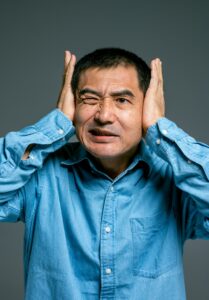Earwax Accumulation and Blockage
The body produces cerumen, or earwax, to protect the ears. Earwax is both lubricating and antibacterial.
Untreated buildup can result in hearing loss, discomfort, ear pain, dizziness, ringing in the ears, and other problems.
Earwax can be removed in a variety of ways, some of which are doable at home.
What exactly is earwax?
The body produces cerumen, or earwax, to protect the ears. Earwax is both lubricating and antibacterial.
Chewing usually transfers old earwax through the ear canal, while the skin in the ear grows from the inside out.
When it reaches the exterior of the ear, it falls off.
Earwax forms on the ear canal’s outer surface rather than deep within the ear. Earwax is created by the combination of dead skin cells and hairs with secretions from two different glands.
What does it mean if your ears are filled with wax?
When earwax accumulates in the ear canal to the extent where it causes indications of a disease, this is referred to as earwax.
It is vital to recognize that the majority of people never need to clean their ears. Ears are designed to clean themselves. Cleaning your ears with cotton or hairpin swabs can cause damage to your ears, resulting in earwax buildup, which can lead to blocked ears.
This just serves to deepen the earwax buildup, raising the risk of irreversible ear damage.
What are the possible consequences of earwax buildup and congestion?
If left untreated, excessive earwax can increase the symptoms of earwax obstruction. There may be hearing loss, ear discomfort, and other symptoms.
Earwax buildup can also make it difficult to see into the ear, allowing possible problems to go undiagnosed.
Is the color of your earwax significant?
Healthy earwax comes in a variety of colors, each with its own meaning. Determine whether you have damp or dry earwax first.
Wet earwax is available in a variety of colors, including pale yellow, honey, and orange-brown. Wet earwax is quite sticky.
Dry earwax is usually white or gray in color and harsh in texture.
Darker earwax is older earwax in both cases. It’s dusty and has had more exposure to air.
You should consult a doctor if your earwax has transformed into a discharge, such as white or greenish pus, or if you notice it on your pillow after sleeping.
If you observe blood or if your earwax is black, you should consult a doctor.
The distinction between moist and dry earwax is another noteworthy element.
Wet earwax is more common in people of European and African origin.
Earwax of Asian, East Asian, or Native American origin is typically drier than other varieties. This has anything to do with genetics.
Those with wet earwax are also more likely to require deodorant. Dry earwax sufferers are weak in a chemical that produces a nice odor.
CAUSES AND SYMPTOMS
What are the symptoms of earwax accumulation and ear congestion?
The following are some of the symptoms of this illness:
There is a sensation of fullness in the ear.
The ear is in pain.
Hearing issues that could worsen in the future
Feeling a ringing in your ear (tinnitus).
In the ear, there is an itching sensation.
The presence of an odor or discharge from the ear.
Dizziness.
DIAGNOSTIC AND EXPERIMENTAL TESTING
Who is affected by earwax accumulation?
Earwax can affect anyone. Children and healthy adults are predicted to be hit by 10% and 5% of the population, respectively.
The following people, however, are more likely to be affected:
People who use hearing aids, earplugs, or earphones.
People with a lot of hair in their ears or with certain skin problems
Individuals who put cotton swabs or other objects in their ears.
Older people.
People who are still in the process of maturing.
Individuals with ear canals that do not allow for natural earwax flow.
Children
Earwax is produced by children. As long as they do not create significantly, be cautious when cleaning their ears. To wipe the outside, simply use a washcloth.
Don’t be alarmed unless your child exhibits earwax buildup symptoms.
Some of the symptoms include pulling or tugging on the ears, pushing items into the ears, and hearing problems. If this is the case, please contact your healthcare provider.
Elderly people
Earwax buildup may be an issue for an elderly person who wears hearing aids. They might even choose to ignore their hearing. Earwax can cause hearing loss, which should be treated.
How are earwax accumulations and blockages detected?
Your healthcare practitioner can use special otoscope equipment to peek inside your ears to see if earwax has formed.
TREATMENT AND MANAGEMENT
What is the best way to treat earwax deposits and blockages?
Earwax can be removed in a variety of ways. Some of these procedures are simple enough to do at home.
You can clean the outside of the ear with a handkerchief. Avoid squeezing the cloth and inserting it into the ear canal.
In the ear canal, cerumenolytic solutions (solutions that dissolve cerumen) can be administered. Among these alternatives are:
Mineral-derived oil.
Oil for infants.
Glycerin.
Hydrogen peroxide or peroxide ear drops (e.g., Debrox®).
A saline solution.
For these solutions, use an eyedropper to place a few drops in the affected ear and lie on the opposite side to allow the solution to drip into the affected ear.
You can also soak a cotton ball in the solution and place it over the affected ear, allowing the solution to seep in.
Another method is to irrigate or inject the ear. Using a syringe, the ear canal is flushed with water or saline solution.
This is normally done after the earwax has been loosened or dissolved with a cerumenolytic.
Finally, your healthcare provider may utilize special instruments to manually remove the cerumen. A cerumen spoon, forceps, or a suction device may be used by the healthcare provider.
If you have tubes in your affected ear or suspect that you do, you should see your doctor straight away (s).
What You Shouldn’t Do When Cleaning Your Ears
Suction devices for the home (such as Wax-Vac®) should not be utilized. They are ineffective for the vast majority of people and should not be used.
Ear candles, which are touted as a natural way to remove earwax, are a flop. Burns to the pinna and ear canal, as well as eardrum perforation, are among the possible effects.
PREVENTION
How can I keep earwax from building up and clogging my ears?
To clean your ears, do not put anything in them. Cotton swabs should only be used on the outside of your ear.
If you need your earwax removed more than once a year, ask your doctor what they recommend to prevent earwax buildup.
Keep in mind that earwax isn’t always a terrible thing. It will not infect your ears as a result of its use. Earwax, on the other hand, can cause problems by itching your ears and preventing you from hearing properly.
It is only safe to use droplets of water to clean the outside of your ears and soften the wax. Before using an instrument to remove earwax, always seek the counsel of your healthcare professional.
Brought To You By – Ear Wax Removal Bury st Edmunds
The post Earwax Accumulation and Blockage appeared first on https://gqcentral.co.uk
The post Earwax Accumulation and Blockage appeared first on https://alef3.com







Comments are closed